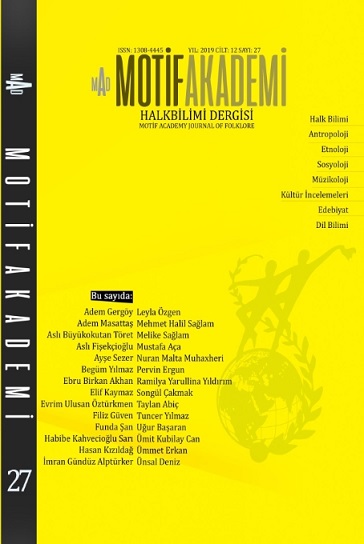KÜLTÜREL DEĞERLERİN MİKRO DÜNYASI OLARAK SANDIK İMAJI
THE IMAGE OF CHESTS AS THE MICROWORLD OF CULTURAL VALUES
Author(s): Ramilya Yarullina YildirimSubject(s): Cultural history, Customs / Folklore, Semiology, Ethnohistory, Turkish Literature, Theory of Literature
Published by: Motif Halk Oyunları Eğitim ve Öğretim Vakfı
Keywords: Tatar literature; Bashkir literature; national values; chest;
Summary/Abstract: Chests, which have had a significant place in the daily lives of people in several cultures from the past to the present, do not lose their main structural function although they have contained unique contents in all periods and cultural settings. This study provides brief information about the place of chests in fold culture from the past to the present and explains the functional characteristics of chests in the case of Tatar and Bashkir stories. Several common features may be observed in the creativity of Tatar and Bashkir artists who deal with the topic of standing against corruption today by preserving the culture of the past and attribute a significant meaning to the image of chests in this process. In literary works, a chest is presented as a word that carries elements of the national culture, a code of a certain culture. The author is concerned with the protective function of a chest and its contents that reflect the traces the national culture, rather than its form. A chest is a microworld that collects national and religious traditions in it and protects them, a box of memory that harbors the most beautiful hopes and valuable memories of the main character; a chest that is assumed to be tangible is, for the elderly, is a living object that is a witness of the past and their abstract thoughts, spiritual values. Antiquated, worn out chests are the most valuable thing that supports the continuation of the past ear in the conditions of the new era for every elderly person. Except for the tale of “master and apprentice”, authors see grandmothers as those who preserve culture and national values and transfer these to future generations and describe them on the level of a symbol as the Mothers of the Nation. Such works that reflect folk culture are also a rich source for studies in the field of ethnolinguistics.
Journal: Motif Akademi Halkbilimi Dergisi
- Issue Year: 12/2019
- Issue No: 27
- Page Range: 600-610
- Page Count: 11
- Language: Turkish

